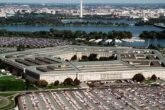March 13, 2025
Sharper: Military Artificial Intelligence
Since the atomic bomb, no technology has the potential to be as disruptive to warfare as artificial intelligence (AI). AI could deliver instant targeting solutions, develop high-powered offensive cyber capabilities, fly planes, and even make decisions on when to fire. The rapid development of military AI brings tremendous warfighting potential but could also introduce significant instability and danger. CNAS experts are sharpening the conversation on balancing the need for United States military AI leadership with safety and collaboration. Continue reading this edition of Sharper to learn more.
Features
Report | Safe and Effective: Advancing Department of Defense Test and Evaluation for Artificial Intelligence and Autonomous Systems
Although the Department of Defense (DoD) has a storied and successful history of deploying increasingly advanced technology in war, AI and autonomous systems present unique challenges, from their lack of explainability in selecting courses of action to their sensitivity to the training data used in developing them. In a new report from Josh Wallin, he writes that as this technology’s development moves at breakneck pace among the United States and its adversaries, now is the time to establish a technically grounded and dynamic framework across the Joint Force to ensure the DoD continues its history of safe and effective deployment.
Around the Center | CNAS Launches New Initiative on AI in Future Warfare
This week, the CNAS Defense Program launched a new initiative on the future of AI in warfare. AI and autonomy have the potential to fundamentally change how wars are fought today and in the future. Already, these tools are rapidly being incorporated into military operations and planning processes, with AI-enabled targeting tools and autonomous drones altering the calculus in conflicts from Ukraine to the Red Sea. This initiative will explore how the United States and its key allies could employ military AI and autonomy in future conflict, the technical and policy changes needed to achieve future visions of AI-enabled combat, and how AI and autonomy may provide unique military advantages.
Safe and Effective
The promise of artificial intelligence (AI) and autonomy to change the character of war inches closer to reality...
CNAS Launches New Initiative on AI in Future Warfare
Washington, March 10, 2025 – The Center for a New American Security’s (CNAS) Defense Program is launching a new initiative examining the critical role of artificial intelligen...
Report | Averting AI Armageddon: U.S.-China-Russia Rivalry at the Nexus of Nuclear Weapons and Artificial Intelligence
In recent years, the previous bipolar nuclear order led by the United States and Russia has given way to a more volatile tripolar one, as China has quantitatively and qualitatively built up its nuclear arsenal. Simultaneously, significant AI breakthroughs could inject new instability into this already rapidly shifting nuclear power structure. As Russia and China increasingly aim to modernize their nuclear arsenals and integrate AI into their militaries, it is essential for policymakers to be aware of the risks posed by the AI-nuclear nexus. In this report, Jacob Stokes, Colin Kahl, Andrea Kendall-Taylor, and Nicholas Lokker lay out how the United States can address these risks.
Commentary | Build Allied AI or Risk Fighting Alone
Working in coalitions, a particular strength of Western nations, depends on interoperability—the ability to conduct military operations together. While this has been difficult even before the recent boom in machine learning, AI and autonomy present new challenges that militaries will have to confront. As each country races to build up their own AI arsenal, now is a critical time to establish the foundations of this interoperability—before the real fight begins.
Averting AI Armageddon
In recent years, the previous bipolar nuclear order led by the United States and Russia has given way to a more volatile tripolar one, as China has quantitatively and qualitat...
Build Allied AI or Risk Fighting Alone
Amid the hype about artificial intelligence (AI) and autonomous systems, militaries around the world are developing, experimenting with, and integrating these tools into every...
In the News
Commentary and Analysis from Paul Scharre, Jacob Stokes, Josh Wallin, and Samuel Bendett
How Israel Uses AI in Gaza—And What It Might Mean for the Future of Warfare
AI warfare may conjure images of killer robots and autonomous drones, but a different reality is unfolding in the Gaza Strip...
The U.S. Is Already Fighting the World’s First AI War—And China Is Winning
AI’s role in warfare is not just about who has the best autonomous weapons—it’s also about who can use AI to make decisions faster than their adversary....
Ukraine Collects Vast War Data Trove to Train AI Models
As the future of warfare pivots towards artificial intelligence, Ukraine is sitting on a valuable resource: millions of hours of footage from drones which can be used to train...
Pentagon’s Priority on AI Spending Could Shield It from Cuts
Josh Wallin, a fellow in the Center for a New American Security’s defense program, predicted that DOD’s planned AI expenditures would be “relatively safe” in future budgets — ...
More from CNAS
-
DEFAERO Strategy Series [Apr 09, 25] CNAS' Becca Wasser and Phil Sheers on Revitalizing the U.S. Defense Industrial Base
On this episode of the Defense & Aerospace Report Strategy Series, sponsored by General Atomics Aeronautical Systems, Becca Wasser and Phil Sheers of the Center for a New Amer...
By Becca Wasser & Philip Sheers
-
From Production Lines to Front Lines
Executive Summary The U.S. defense industrial base (DIB) is struggling to meet the demands of the current strategic environment—let alone prepare for a potential conflict agai...
By Becca Wasser & Philip Sheers
-
The Pentagon’s Endangered Brain Trust
In this environment, sound assessments of emerging threats and new ideas to counter them will be especially vital....
By Dr. Andrew Krepinevich, Jr.
-
Siliconsciousness: The AI Competition: Public Policy Strategies: Part 1
This episode comprises the first part of our special event, “The AI Competition: Public Policy Strategies”. The event, co-hosted by MIT Technology Review, brings together some...
By Dr. ED McGrady












